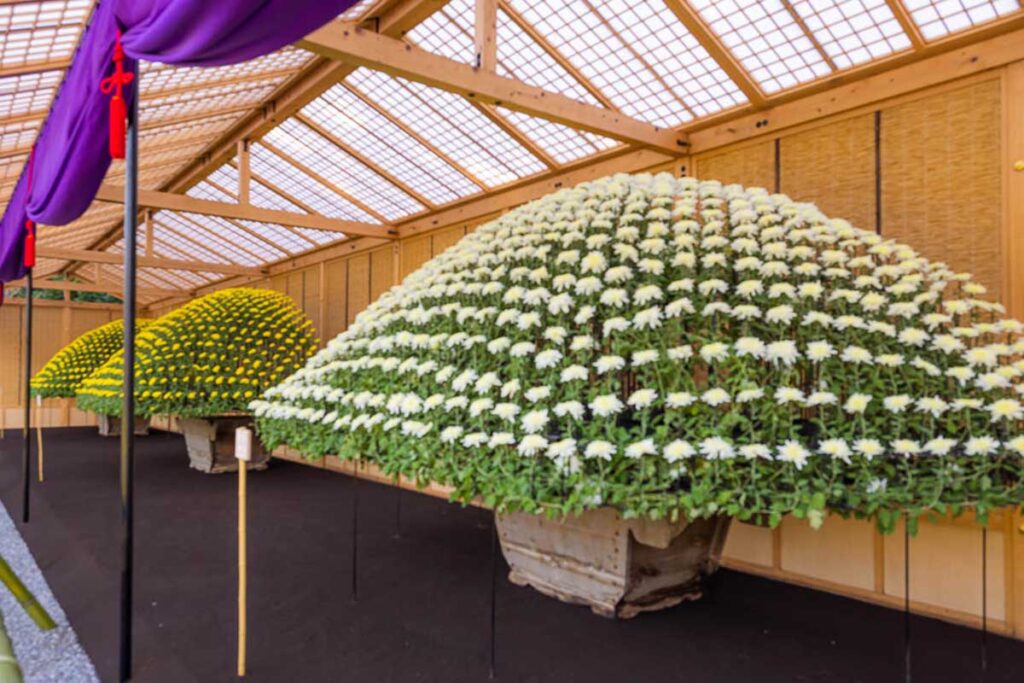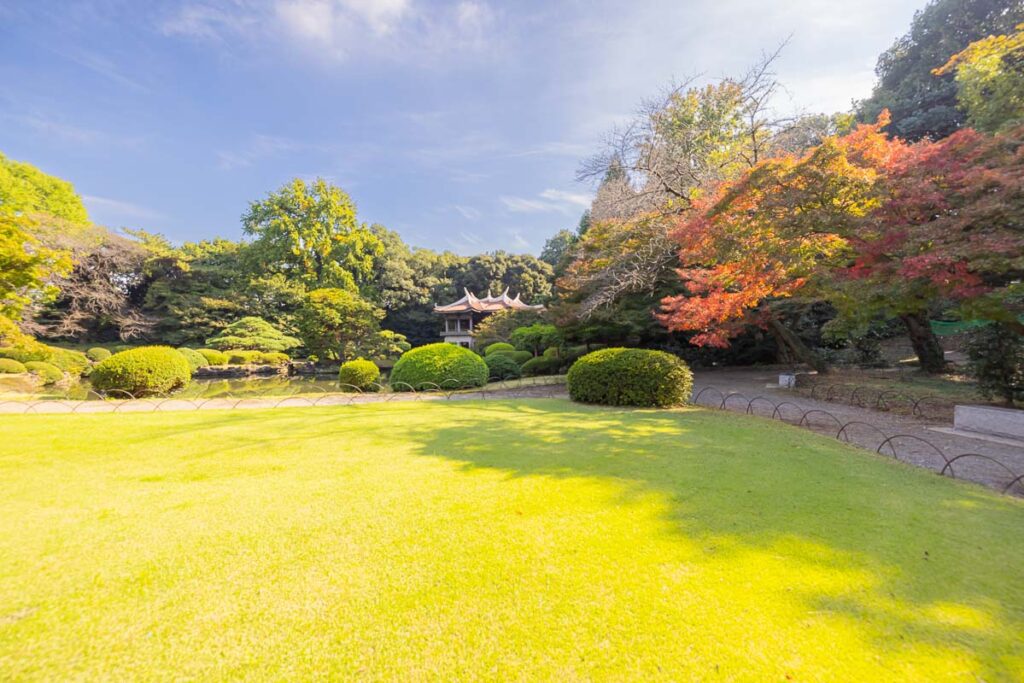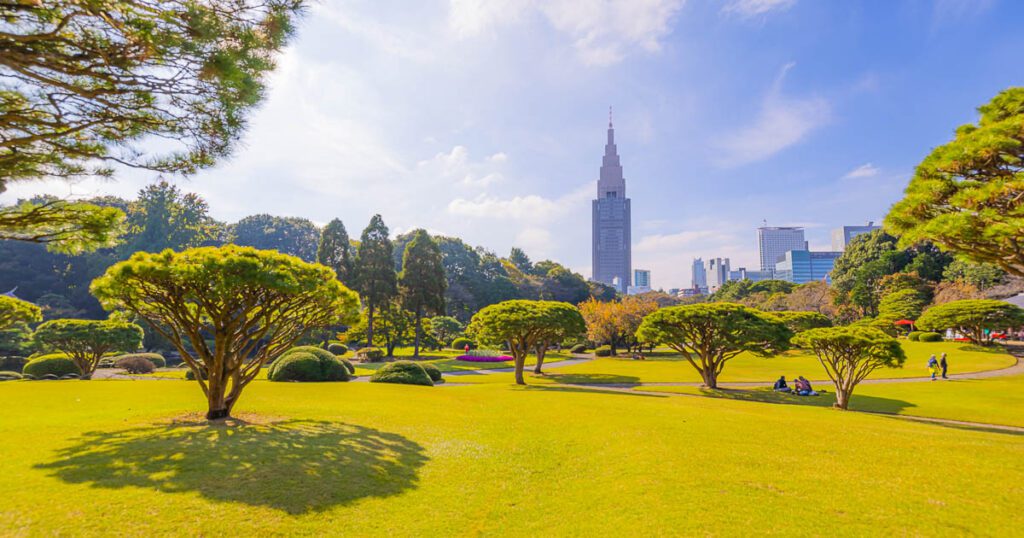Amid Tokyo’s ultra-modern skyscrapers and buzzing streets, a serene sanctuary breathes life, color, and tranquility into the urban landscape. This peaceful haven is the Shinjuku Gyoen National Garden – a vast, beautifully manicured park that seamlessly blends East and West, tradition and innovation, nature, and architecture.
Location:
The park is in the heart of Tokyo’s lively district Shinjuku. Shinjuku Gyoen is an oasis that spans 144 acres. Yet, it’s not just a park; it’s a celebration of nature, style, and serenity that offers an escape from the city’s hustle and bustle.
When you step inside, you’ll realize you are instantly transported into a whole new world. The noisy sounds of Tokyo fade away, replaced by the rustling of leaves, the chirping of birds, and the soothing trickle of water features. The garden is a marvelous juxtaposition of three distinct styles:
- the French Formal Garden,
- the English Landscape Garden, and
- the Japanese Traditional Garden.
Three Famous Gardens:
The French Formal Garden, characterized by its symmetry and meticulously trimmed shrubbery, conjures images of European nobility leisurely strolling along its gravel paths. Seasonal flowers add splashes of color, creating a living, breathing painting that changes throughout the year.
A stroll away, the English Landscape Garden awaits with its gentle, rolling lawns, mature trees, and tranquil pond. Here, nature unfolds in a seemingly organic yet carefully planned manner. It’s a perfect place to spread a picnic blanket, lose yourself in a good book, lie back, look up, and watch the clouds float by.

But it is arguably the Japanese Traditional Garden that is the heart and soul of Shinjuku Gyoen. This garden is an elegant display of Japan’s rich botanical heritage and gardening philosophy. Its gracefully pruned trees, artfully arranged rocks, serene ponds filled with koi carp, and charming tea houses embody the spirit of ‘wabi-sabi.’ The Japanese aesthetic focuses on embracing impermanence and imperfection.
One of the highlights of Shinjuku Gyoen is undoubtedly its cherry blossom season. The park boasts more than a thousand cherry trees, which transform the park into a breathtaking spectacle of pale pink blossoms when in full bloom. It is a mesmerizing experience that year after year, this place attracts visitors from all corners of the world.
Why visit?
Yet, no matter when you visit Shinjuku Gyoen National Garden, there is always something magical to discover. From the fiery reds and oranges of autumn leaves to the soft pink hues of spring cherry blossoms, from the snow-kissed landscapes of winter to the verdant greenery of summer, the park offers an ever-changing tableau of nature’s beauty.
Amid the concrete jungle of Tokyo, Shinjuku Gyoen stands as a testament to the harmonious co-existence of the urban and the natural. It’s a place where one can take a deep breath, let go of their worries, and immerse themselves in the timeless beauty of nature.

So whether you’re a resident of Tokyo seeking respite from the city’s pace, or a traveler exploring the heart of Japan, Shinjuku Gyoen National Garden is a destination that inspires, refreshes, and enchants.
In addition, you can visit Omoido Yokocho and Golden Gai. These famous tourist spots are only a few minutes from the garden.
Opening hours:
9:00-18:00
Open every day
Admission:
Adult: 500 yen
How to access it?
Visiting Shinjuku Gyoen National Garden is easy and fun! Here’s how you can get there:
By Train:
The easiest way to reach Shinjuku Gyoen is by train. The park has three entrances, and each is close to a different train station.
- The Shinjuku Gate is about a ten-minute walk from the ‘New South Exit’ of JR Shinjuku Station or about a five-minute walk from Shinjukugyoenmae Station on the Marunouchi Subway Line.
- The Okido Gate is also a five-minute walk from Shinjukugyoenmae Station on the Marunouchi Subway Line.
- The Sendagaya Gate is a five-minute walk from JR Sendagaya Station on the local Chuo/Sobu Line.
By Bus:
If you prepare a bus, you can take the Toei Bus number 77 and get off at the Shinjuku Gyoen stop.
Remember to bring some money for the entrance fee. The entrance fee is 500 yen for adults, and children can enter for free. Also, check for any updates or changes before your visit.
Once there, you can explore the park, have a picnic, and enjoy a fun day in nature. Remember to take some photos! The park is beautiful, and you’ll want to remember your adventure.
Address:
11 Naitomachi, Shinjuku City, Tokyo 160-0014, Japan
Official website:
